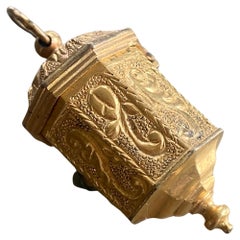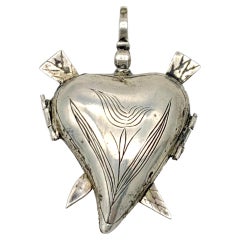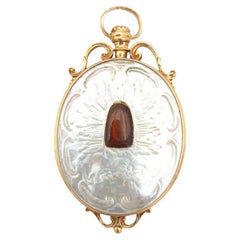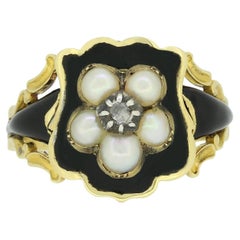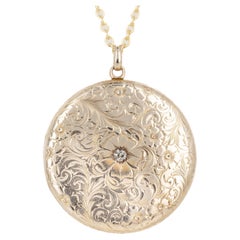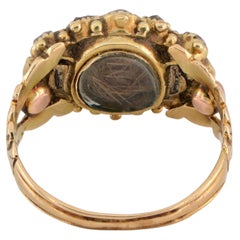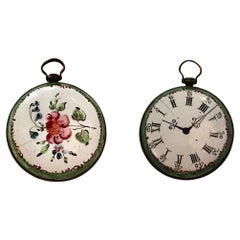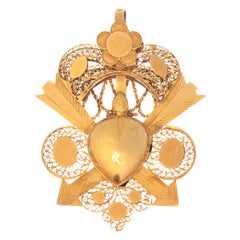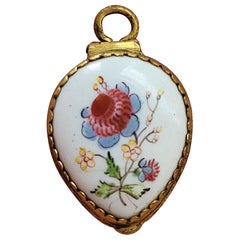18th Century Lockets
Antique Mid-18th Century French Collectible Jewelry
Gold
Antique Early 18th Century German Baroque Pendant Necklaces
Silver
Antique 1790s Italian Georgian Pendant Necklaces
18k Gold
Antique 18th Century Georgian Engagement Rings
Diamond, Pearl, Gold, Yellow Gold, Enamel
Antique Late 18th Century Victorian Pendant Necklaces
Diamond, 10k Gold, Yellow Gold
Antique Late 18th Century British Georgian Cluster Rings
Diamond, 18k Gold
Antique 1790s English Collectible Jewelry
Enamel
Recent Sales
Antique Late 18th Century Unknown Georgian Pendant Necklaces
Gold, 18k Gold, Yellow Gold
Antique Late 18th Century British Georgian Pendant Necklaces
Copper
Antique Late 18th Century Unknown Late Victorian Beaded Necklaces
Coral, 15k Gold
Antique 18th Century European Georgian Pendant Necklaces
Carnelian, 18k Gold, Rose Gold
Antique Mid-18th Century English Early Victorian Link Bracelets
9k Gold
Antique Late 18th Century Russian Art Deco Pendant Necklaces
14k Gold, Enamel
21st Century and Contemporary American Modern Pendant Necklaces
Gold, 18k Gold, Yellow Gold
English Drop Necklaces
Antique 18th Century German Pendant Necklaces
Enamel, Gilt Metal
Antique 18th Century French Pendant Necklaces
18k Gold
Antique Early 19th Century English George III Pendant Necklaces
Pyrite, Silver
Antique Late 18th Century Austrian Renaissance Revival Pendant Necklaces
Turquoise, Enamel
Antique 18th Century Unknown Victorian Pendant Necklaces
Agate, Rock Crystal, Yellow Gold
Antique 18th Century British Georgian Pendant Necklaces
Pearl, Gold, 22k Gold, 9k Gold, Enamel
Antique 1780s European George III Vanity Items
Silver
Antique 18th Century Portuguese Baroque More Objets d'Art and Vertu
Gold, Yellow Gold
Antique 1780s British George III More Rings
Agate, Garnet, Gold, 15k Gold
Antique 18th Century Unknown Early Victorian Brooches
Natural Pearl, Pearl, Gold, 10k Gold, Silver
Antique Mid-18th Century French Pendant Necklaces
Diamond, Ruby, 18k Gold, Enamel
Antique Late 18th Century Unknown Georgian Pendant Necklaces
Rock Crystal, Rose Gold
Antique Mid-18th Century English Victorian Pendant Necklaces
Agate, 15k Gold
Antique 18th Century British Victorian Pendant Necklaces
Pearl, 15k Gold, Enamel
Antique Late 18th Century Victorian Beaded Necklaces
Onyx, Pearl, 14k Gold, Yellow Gold
Antique Late 18th Century English George III Grandfather Clocks and Long...
Brass
Antique 18th Century British Georgian Pendant Necklaces
18k Gold
Antique 18th Century English George III More Rings
Garnet, 15k Gold
People Also Browsed
Late 20th Century Scarves
21st Century and Contemporary Drop Necklaces
Diamond, 18k Gold
1950s American Day Dresses
1970s French Cocktail Dresses
1990s American Artisan Pendant Necklaces
Enamel, Gilt Metal
Early 20th Century Brooches
Crystal
Antique Late 19th Century Japanese Japonisme Lacquer
Wood, Lacquer
Antique 1870s British Victorian Beds and Bed Frames
Brass, Iron
Early 20th Century Russian Art Nouveau Models and Miniatures
Metal, Gold
Vintage 1970s French Mid-Century Modern Sofas
Leather, Foam
Early 20th Century Unknown Edwardian Pendant Necklaces
Pearl, Diamond, Peridot, Gold, 14k Gold, Yellow Gold
Vintage 1920s French Art Deco Pendant Necklaces
Diamond, Emerald, Black Opal, Opal, Platinum
Antique 18th Century Italian Baroque Cabinets
Wood
Antique 19th Century Unknown Victorian Pendant Necklaces
Amethyst, Gold, 14k Gold, Yellow Gold
Vintage 1910s French Art Deco Bottles
Blown Glass
Vintage 1960s American More Necklaces
Diamond, Pearl, 18k Gold
18th Century Lockets For Sale on 1stDibs
How Much are 18th Century Lockets?
- 1stDibs ExpertNovember 13, 2024To identify 18th-century furniture, you can research your piece in the context of the prevailing styles of the period or consult a certified appraiser or experienced antique dealer. To identify your item on your own, look over it for maker's marks, such as carvings, stamps, brands and labels. Researching the marking can help you determine the maker of your piece, and from there, you can search further to learn more about your particular item. Without a maker's mark, the best approach is to consider the characteristics of the dominant furniture styles during the 18th century. In England, these included William and Mary, Queen Anne, Georgian, Chippendale, Hepplewhite and Sheraton. Some French furniture styles of the 1700s include Louis XV, Louis XVI and Régence. Find a diverse assortment of 18th-century furniture on 1stDibs.
- 1stDibs ExpertApril 5, 2022Yes, wedding rings have a long history, stretching back to ancient Egypt. The first diamond engagement ring was created in 1477 by Archduke Maximillian of Austria. Browse a wide array of vintage and contemporary wedding rings on 1stDibs.
- 1stDibs ExpertApril 5, 2022In the 18th century, art changed in style from Baroque to Rococo and Neoclassicism. Art became more ornamented and idealized during the Rococo period and then shifted toward a style that emulated the artwork of ancient Greece and Rome near the end of the century. You’ll find a variety of fine art on 1stDibs.
- 1stDibs ExpertApril 5, 2022One way to check if your brass candlesticks are from the 18th century is to look for the two seams running lengthwise on either side. This is from when the candlestick was molded in two halves and then soldered together. You’ll find a variety of candlesticks of all shapes and sizes from some of the top sellers on 1stDibs.
- 1stDibs ExpertJanuary 10, 2025The individuals considered the Big Three of 18th-century cartoons are William Hogarth, James Gillray and George Cruikshank. Although the 18th century saw a widespread increase in illustrations in newspapers, these three illustrators were particularly well-known for their work. Hogarth's work was extremely diverse, ranging from serious, realistic paintings and portraits to satirical and moralistic illustrations filled with symbolism. A British caricaturist, Gillray is remembered today for his artworks representing political and social satires, like his political cartoons against George III of England. Despite being a prolific caricaturist, Cruikshank is now most famous for illustrating the works of Charles Dickens. On 1stDibs, find a wide variety of illustrations.
- 1stDibs ExpertApril 5, 2022At the end of the 17th century, Europe went into a frenzy over porcelain. Asian porcelain was highly sought after, and spurred the foundation of the Meissen factory in France, where hard porcelain went on to be made. You’ll find a large collection of porcelain pieces from many of the world’s top sellers on 1stDibs.
- 1stDibs ExpertApril 5, 2022Yes, the history of glass-making goes back much further than the 1600s. It’s believed that they were making glass in different parts of the world at least 3,600 years ago, maybe even longer. During the late Bronze Age in Egypt and in Western Asia, glassmarking advanced significantly and was manipulated extensively to produce vessels, jewelry, and works of art. Shop a range of antique and vintage glass on 1stDibs.
- 1stDibs ExpertMarch 22, 2022Yes, there were cannons in the 16th century. The history of the weapon dates back to 12th-century China. Historical records suggest that the first cannons appeared in Europe during the Islamic wars in Iberia in the 13th century. Find a range of antique cannons on 1stDibs.
- 1stDibs ExpertApril 5, 2022What painting is the most important of the 20th century is largely a matter of personal opinion. Some notable works produced during the period include Paul Cézanne's Mont Sainte-Victoire, Pablo Picasso's Les Demoiselles d'Avignon, Henri Matisse's The Dance and Jackson Pollock's Lavender Mist. Shop a large selection of 20th-century paintings on 1stDibs.
- 1stDibs ExpertApril 5, 2022A variety of furniture was used during the 16th century. Items commonly found in homes include high-backed armchairs, chests, stools, benches and cupboards. Most European artisans active during the time period produced pieces out of oak wood. Find a large collection of antique furniture on 1stDibs.
- 1stDibs ExpertSeptember 23, 2024What 17th-century furniture is called varies. The general term for all furniture produced 100 years ago, including 17th-century pieces, is antique furniture. You may also choose to be more specific and describe a piece by its style. Theatrical and lavish, the Baroque style was prevalent across Europe from the 17th to the mid-18th century and spread around the world through colonialism, including in Asia, Africa and the Americas. Baroque furniture was extravagant in all aspects, from shape to materials. 17th-century pieces from England often feature characteristics of the William and Mary style, such as crisp lines, maple and walnut veneers, inlaid bands and C-scroll ornaments. On 1stDibs, explore a variety of antique furniture.
- 1stDibs ExpertApril 5, 2022Sir Isaac Newton invented the reflector telescope in the 17th century. He created it as a replacement for the refracting telescope, which tended to have poor optics. Find a collection of antique and vintage telescopes on 1stDibs from some of the world’s top sellers.
- 1stDibs ExpertApril 5, 2022British artist John Singer Sargent was one of the most important portrait painters of the 19th century. Other notable portraitists from the period include James Abbott McNeill Whistler, Eugène Delacroix, Théodore Géricault, Gustave Courbet, Édouard Manet, Mary Cassat, Claude Monet and Pierre-Auguste Renoir. On 1stDibs, find a wide variety of portrait paintings.
- 1stDibs ExpertApril 5, 202217th-century Dutch portraiture has many similarities to other Baroque paintings, including rich colors, dark shadows and intense lighting. Many famous Dutch Baroque works lean toward realism. In Dutch portraiture, props and detailed backgrounds are uncommon. You'll find a collection of Dutch Baroque paintings from some of the world’s top art dealers on 1stDibs.
- 1stDibs ExpertApril 5, 2022The French painters of the 19th century worked in two styles. Neoclassicism dominated the first half of the century, and Impressionism was the most common style during the second half. On 1stDibs, you can find a variety of French paintings.
